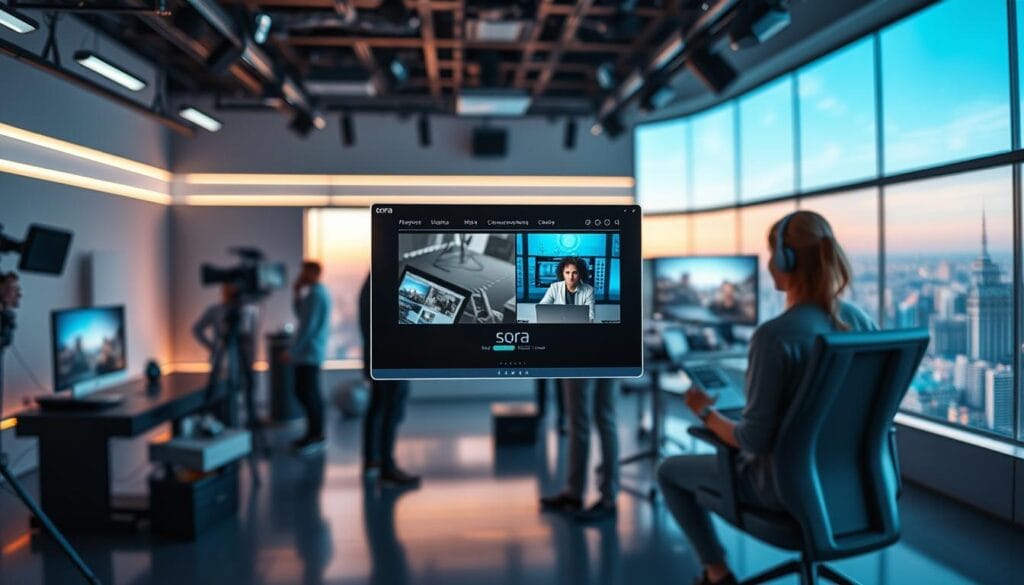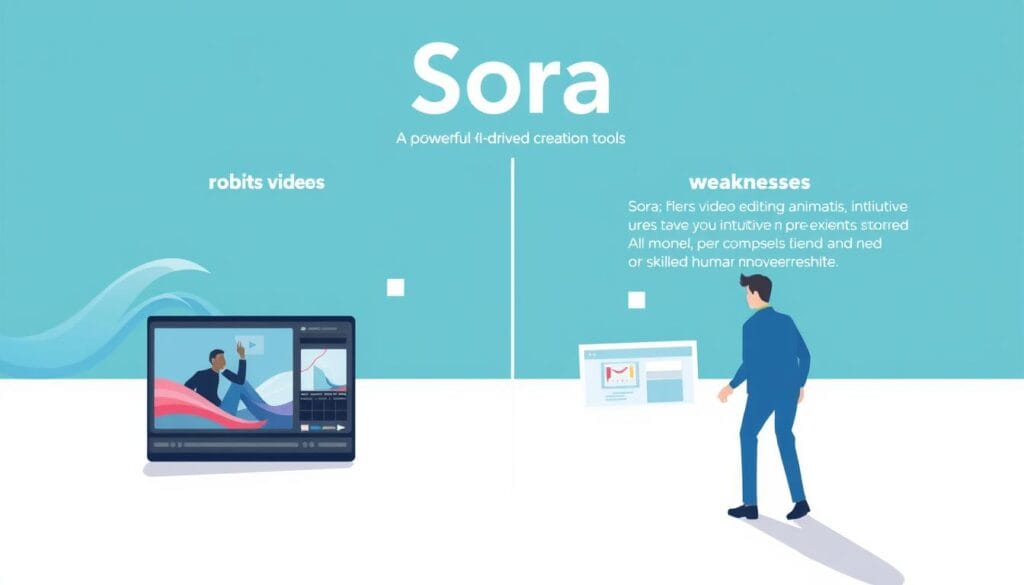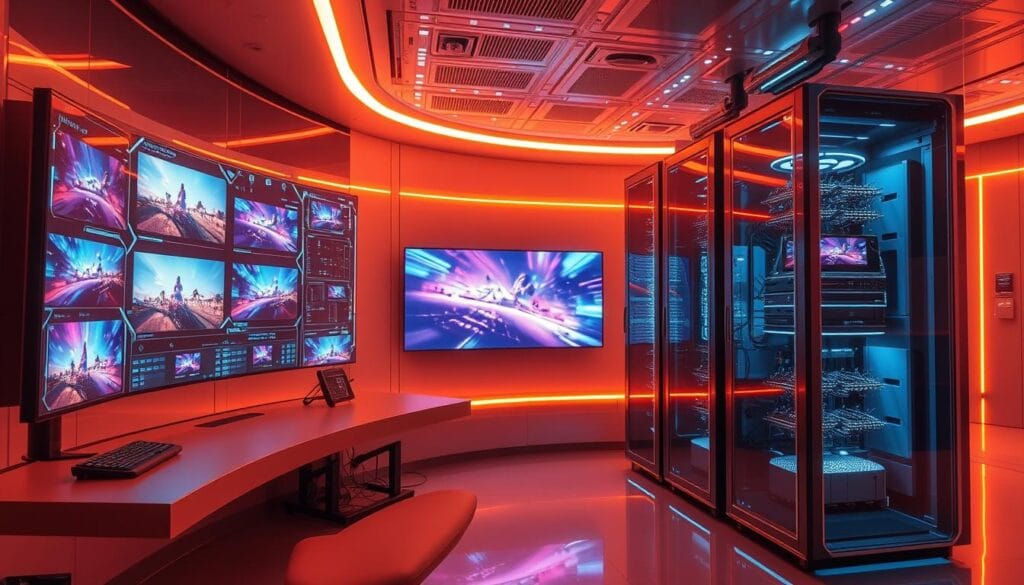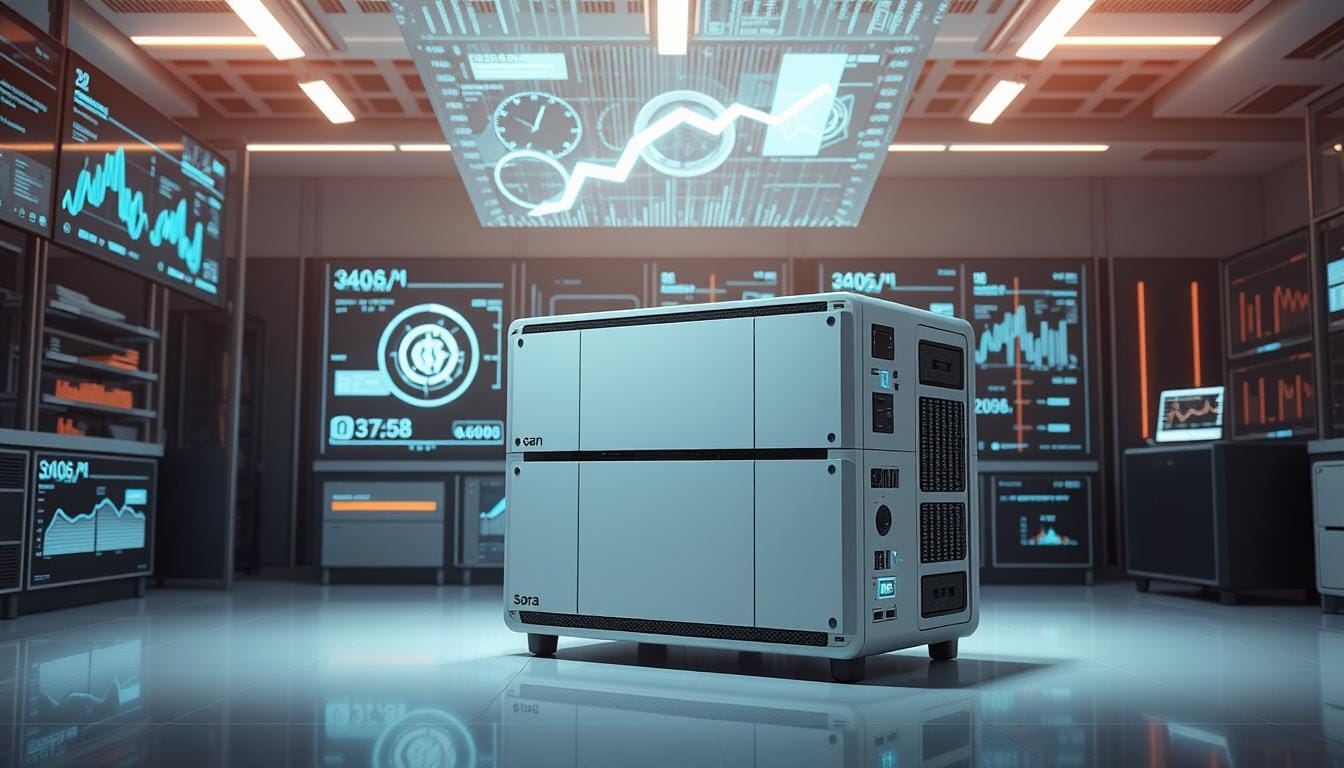In today’s world, Sora AI is changing how we make AI-generated videos. It turns text into amazing visuals, letting creators tell stories without limits. This tech uses advanced tech like natural language processing and machine learning, setting a new standard for making videos.
Sora can make videos up to a minute long in high definition. It’s making a big splash in fields like marketing, education, and entertainment. Its algorithms are super smart, understanding complex ideas and creating videos that excite and worry people.
This article looks at how Sora is different from others. It talks about its cool uses and the big questions it raises. As OpenAI grows, it’s changing how we make content, bringing up big ethical issues.
Key Takeaways
- Sora can generate videos up to one minute long at a resolution of 1080p.
- It uses advanced algorithms trained on billions of patterns from the physical world.
- Sora’s technology democratizes video production, making it accessible to more creators.
- The implications raise ethical concerns regarding the authenticity of AI-generated content.
- Potential applications span multiple industries, including marketing, education, and entertainment.
Introduction
The digital world is changing fast, with big steps in video creation technology. Now, we can make high-quality videos with advanced algorithms. Sora is a top example, turning text into detailed 60-second videos.
This shows how real videos can look today. It also changes how creators talk to their audience.
Sora uses ideas from DALL-E 3, combining models for easy video making. It started with a few experts but wants to help more people. It’s for anyone who wants to tell stories or share ideas without needing a lot of money or special skills.
Sora was shown off in February and will be available to everyone on December 9th. It’s a big step in AI video making, like DALL-E was for pictures.
It can make videos in 1080p and supports different video sizes. This is a big moment for AI video making.
Understanding AI-Generated Videos
AI-generated videos are changing how we tell stories with pictures. They show how fast AI video tech is getting better. Now, creators can make videos that look real and grab your attention. Sora AI is a great example of this, using smart tech to make videos.
The Rise of AI in Video Production
More people want high-quality videos than ever before. AI videos can make amazing footage fast. Sora helps both new and experienced creators, offering different levels of help.
ChatGPT Plus users can make up to 50 videos a month. Pro users can make as many as they want. Even free users get to see new videos every day.
How Sora AI Functions
Sora AI is a big step forward in making videos from text. It mixes pictures and movement to match what you want. It’s like a video editor online, making it easy to mix different things.
As creators learn what Sora can do, it opens up new ways to be creative. It’s becoming a key part of making videos in the future.
Advancements in Text-to-Video AI Models
The world of video making is changing fast thanks to new text-to-video AI tech. Sora is leading the way, showing off new ways to make videos. It uses smart AI to make videos that look amazing and have lots of details, just like real movies.
Key Technologies Behind Sora
Sora uses a special design called a diffusion transformer. This design makes videos look better. It works with small parts of images to make videos that are clear and sharp, up to 1080p.
Sora can make videos up to a minute long and with different scenes. This lets creators tell longer stories and make videos more engaging for viewers.
Sora is also very good at showing the real world. This is important because AI videos can sometimes look fake. OpenAI is always working to make Sora better, using lots of video data. This makes Sora even better at creating videos, helping creators be more creative.
Comparison to Other Models
When we compare Sora to Runway and Pika, Sora stands out. Runway helps creators work together better, and Pika is good at basic animation. But Sora is all about making videos that look real and are of high quality. It’s great for making videos for games and other visual projects.
OpenAI is always improving Sora, showing they’re committed to making it better. This means we can expect even more amazing video tech in the future. Sora is changing how we tell stories in videos, making it easier for everyone to create.
Sora Unveiled: Revolutionizing Video Creation with AI Innovation
Sora is changing the game in AI video creation. It lets creators make videos up to 60 seconds with just text. Unlike old methods, Sora uses a special model to make videos smooth and real.
This new way makes it easy to create complex scenes with lots of characters. Sora’s smart design makes sure everything moves and looks right. This could be huge for education, making learning fun and personal.
Users can adjust things like style and camera angles with Sora. This makes creating videos more fun and personal. It’s all about trying new things and getting better with each video.
Working with other video tools makes Sora even more useful. It could change how we make and share videos in many fields. This could mean more content that really speaks to people.
This tech wants to make video making more accessible. It could help more people share their stories. But, it also raises questions about jobs and how things might change.
By sharing Sora’s code, we could see even more cool stuff. But we need to make sure we’re using it right. Working together with experts is key to making sure Sora is used well.

A Comparison of Sora, Runway, and Pika Video Generators
The world of AI video platforms is changing fast. Sora, Runway, and Pika are at the forefront. Each has its own strengths, making it important to compare them.
Sora is made for solo creators and small businesses. It offers high-quality videos that look real. It’s good for many fields, like education and healthcare. Sora also focuses on using AI responsibly and respecting copyrights.
Pika is for animators and game makers. It’s great for those in the entertainment world. Runway, on the other hand, is for artists, designers, and video editors. It has many AI tools for creative work.
| Feature | Sora | Runway | Pika |
|---|---|---|---|
| User Accessibility | Subscription-based (ChatGPT Plus and Pro) | Web-based, accessible on Chrome | Available online |
| Maximum Video Length | 60 seconds | Varies by application | Up to 20 seconds |
| Focus Area | Independent creators, small businesses, education | Artists, designers, video editors | Animators, game developers |
| Video Resolution | Up to 1080p | Varies by project | Variable quality |
| User-Friendliness | Very easy | Requires tutorials | Requires technical knowledge |
| Simultaneous Video Generation | Yes | No | No |
| Unique Feature | Ethical use and copyright compliance | Multiple creative applications | Animation with lip-syncing |
This Sora comparison with Runway and Pika shows how each tool is best for different tasks. It helps users make the right choice for their needs.
Analyzing the Strengths and Weaknesses of Current Models
Today’s AI video models have both strong points and areas for improvement. They affect how users feel and what they expect. Looking at realism and physics simulation challenges gives us a full picture of what they can do and can’t.
Realism and Detail in AI Videos
Sora leads in realism in AI-generated videos. It can make videos up to a minute long, a big step up from before. It uses special tech to capture looks and movements well, making stories that follow what users want.
It also uses a big language model trick to make videos look great. This makes Sora very good at creating eye-catching videos.
People like how Sora can make 3D scenes without needing to model them. This lets it move cameras and keep scenes looking real. It’s great for learning, making videos that help students get better.
Sora can make videos in different sizes and shapes, keeping quality high.
Challenges in Physics Simulation
Even with its strengths, Sora faces big challenges in physics. It’s great at making things look cool, but it’s not always right about how things move. This shows Sora’s weaknesses and what it needs to get better at.
As more AI video models come out, knowing Sora’s good and bad points is key. It’s a useful tool, but we need to watch its flaws to make it even better.

The Future of Video Generation AI
The world of video generation AI is changing fast. Thanks to new tech, making and watching videos is getting easier. Platforms like Sora are leading the way, giving creators new chances to make videos.
These changes help filmmakers, teachers, and marketers work better together. They can mix technology with creativity in new ways.
Upcoming Trends in AI Video Production
Sora’s future looks bright, promising to make video making easier. Now, users can make great videos from just text, a big change from old methods. This shows AI is making content creation simpler and more fun.
Experts think the stock footage world will change a lot. Sora and similar tools might make making videos cheaper and more flexible.
Opportunities for Collaboration with Creatives
Working together is going to get better with Sora. It lets artists and creators team up easily. Features like storyboarding and photo animation make it simple for everyone to contribute.
It’s a chance for new ideas and content that really speaks to people. This way, creators can make videos that fit their unique style. It also helps reach audiences that traditional stock footage might miss.
| Feature | Sora | Traditional Stock Footage |
|---|---|---|
| Creation Time | Minutes | Hours to Days |
| Cost Efficiency | Lower Costs | Higher Costs |
| Customization | High | Limited |
| Output Quality | High Resolution (up to 1080p) | Varies |
| Ethical Compliance | Strict Guidelines | Varies |
In short, AI video production is changing the media world a lot. Sora is a big part of this change. It offers tools that make creating videos easier and encourage teamwork in the creative field.
The Technical Architecture Behind Sora
The Sora technical architecture is a video generation framework that boosts video creation. It uses a transformer architecture, known for handling big datasets well. This lets Sora create scenes with many characters and actions, showing AI’s power in video making.
Sora uses a diffusion model to make videos all at once, not frame by frame. This makes it faster and keeps the video’s flow smooth. It also makes sure the video looks consistent, a big challenge for AI models before.
Sora also makes objects move and act like they do in the real world. It lets creators change things like style and camera angles. This makes it easy to try out different ideas and find the best look.
Sora works well with other video editing tools, making it easy to use. It can make high-quality videos up to 60 seconds long. This is great for teachers who want to make learning fun and engaging.
Sora is leading the way in AI video making. It wants to make video creation easier for everyone, including those from underrepresented groups. It’s also changing the entertainment world, making things like AI trailers and music videos possible.
| Feature | Description |
|---|---|
| Video Length | Generates videos up to 60 seconds long |
| Architecture | Based on transformer model; uses diffusion architecture |
| Scene Complexity | Handles complex scenes with multiple characters |
| Realism | Incorporates physical dynamics for realistic interactions |
| Customization | Customizable style, camera angles, and pacing |
| Integration | Seamless integration with existing video editing tools |
The Training Process of the Sora Model
The Sora model’s training is crucial for its ability to create amazing videos from text. It needs lots of computing power to work well. This is important for developers and creators to know.
Resource Allocation for Video Generation
AI needs good resource management for Sora’s training. It uses 4,200 to 10,500 Nvidia H100 GPUs for a long time. This lets the model learn how to make videos well.
Each GPU can make about five minutes of video every hour. This shows how much power is needed for high-quality videos. This setup helps train the model fast and well.
Fine-tuning for Quality Output
After the first training, Sora gets fine-tuned. This step makes the videos look even better. It removes any bad parts and makes the frames smooth.
The fine-tuning uses special algorithms. These adjust to what users need. This way, Sora can make videos in different sizes and shapes. It makes AI in video creation even better.
Exploring Enhanced Outputs with Increased Compute
More compute power in AI leads to better video outputs. For instance, Sora can make videos up to 2048×2048 pixels. This shows what’s possible with more computing power.
To make AI videos better, you need strong infrastructure. Sora uses a huge dataset of thousands of hours of video. More computing power means better visuals, almost like professional movies.
Sora uses special tech to turn static images into moving videos. It gets better at handling complex scenes and keeping 3D consistency. This makes it great for creators and industries like healthcare and finance.

As tech gets better, animating images and blending videos will become more important. Using Sora for new storytelling ways shows the need for more computing power. It’s key for creatives to get the best results.
Limitations and Challenges of Sora
Sora is making waves in the AI-generated video landscape, yet it is not without its challenges. Significant Sora limitations affect user experience and output quality. For instance, videos created by Sora can reach up to 20 seconds in length at a resolution of 1080p for full subscribers. This is modest compared to competitors like Google’s Veo 2, which delivers longer durations and 4K resolution. These limitations prompt concerns over the value of a $200 monthly subscription, making users question alternatives like stock video platforms.
The technical challenges in AI-generated videos further complicate matters. Sora has difficulties maintaining coherence in longer sequences and simulating realistic physical interactions. Users report instances where complex prompt interpretations lead to physically implausible motions. For example, depicting a character walking on air or spontaneous appearances of additional entities can undermine the video’s realism.
Sora’s current capabilities also fall short in capturing the subtleties found in human-crafted videos. Users have expressed skepticism, questioning the cost-to-value ratio. Given the issues with implementation, including lack of sound and limited support for nuanced depiction, some potential subscribers might hesitate to adopt the platform once publicly available. Currently, Sora is not accessible to the broader audience, being restricted to a select group of researchers and professionals.
Conclusion
Sora AI is a game-changer in video production. It uses machine learning to make videos faster and more diverse. This technology helps in many areas, like health and education, showing AI’s power.
Sora can learn quickly and tackle new tasks. It combines different AI techniques to be both flexible and strong. OpenAI makes sure Sora works in a way that respects human values.
The future of video looks bright with Sora. It could team up with artists to create amazing stories and visuals. Even though it faces some hurdles, like making complex scenes, it will keep getting better with feedback.
FAQ
What is Sora?
Sora is a cutting-edge AI tech that turns text into amazing videos. It uses advanced tech like natural language processing and machine learning. This makes videos that grab your attention.
How does Sora compare to other video generation models?
Sora beats models like Runway and Pika in quality and realism. It makes videos that look like they were shot by a pro. This is thanks to its top-notch tech.
What industries can benefit from Sora’s technology?
Many fields can use Sora, like marketing, education, and filmmaking. It offers new ways to tell stories and create content.
What are some challenges faced by Sora?
Sora faces some hurdles. It can only make short videos, has trouble with complex prompts, and sometimes adds weird visual stuff.
How does Sora’s training process work?
Sora needs lots of computer power to learn how to make videos. It aims to make high-quality videos while being efficient.
What technical architecture supports Sora?
Sora uses a special architecture called transformers. This helps it learn from huge datasets. It makes videos that flow well together.
What advancements does the future hold for AI video generation?
The future of AI video looks bright. We’ll see more AI in creative work and better tech for making videos.
How does increased compute power benefit video generation?
More computer power means Sora can make videos that look even better. This makes videos more detailed and clear.
Source Links
- https://www.toolify.ai/ai-news/unleashing-the-power-of-sora-ai-creating-realistic-videos-for-free-2138943 – Creating Realistic Videos for Free
- https://medium.com/@monge/sora-a-new-era-in-ai-driven-video-production-c2073284bff7 – SORA : A New Era in AI-Driven Video Production
- https://medium.com/@moraneus/unveiling-sora-openais-revolutionary-leap-into-text-to-video-ai-technology-d3bed3d31b00 – Unveiling Sora: OpenAI’s Revolutionary Leap into Text-to-Video AI Technology
- https://www.ainvest.com/news/openai-unveils-sora-revolutionizing-video-storytelling-with-ai-magic-24121010ae2d85776cb16374/ – OpenAI Unveils Sora: Revolutionizing Video Storytelling with AI Magic
- https://www.tomsguide.com/ai/ai-image-video/openai-unveils-sora-ai-video-generator-heres-how-to-try-it – OpenAI launches Sora AI video generator — here’s how to try it
- https://www.cmswire.com/digital-experience/openai-unveils-sora-its-impressive-ai-video-generator/ – Meet Sora, OpenAI’s Impressive AI Video Generator
- https://techbullion.com/the-dawn-of-ai-generated-video-exploring-sora-ais-capabilities/ – The Dawn of AI-Generated Video: Exploring Sora AI’s Capabilities
- https://quickcreator.io/myblog/2024-unveiling-future-ai-openai-sora/ – OpenAI Sora: Revolutionizing Video Creation with AI
- https://hyscaler.com/insights/openais-new-sora-model-video-generation/ – OpenAI’s Exciting Sora Model: Revolutionizing Video Generation – HyScaler
- https://medium.com/@cognidownunder/openais-sora-unveiling-the-future-of-video-creation-with-text-prompts-a-deep-dive-29dd293fc988 – OpenAI’s Sora: Unveiling the Future of Video Creation with Text Prompts — A Deep Dive
- https://www.geeky-gadgets.com/openai-sora-ai-text-to-video-ai-generator-officially-launches/ – OpenAI Sora AI Text-to-Video AI Generator Officially Launches
- https://filmora.wondershare.com/ai/openai-sora-case-study-and-application.html – Practical Case Studies and Applications Revealed
- https://arxiv.org/html/2402.17177v3 – A Review on Background, Technology, Limitations, and Opportunities of Large Vision Models
- https://www.linkedin.com/pulse/how-sora-text-to-video-ai-model-transform-businesses-rachel-pang-q9wbc – How Sora, the text-to-video AI model, will transform businesses
- https://www.toolify.ai/ai-news/openai-sora-revolutionizing-video-creation-or-just-a-gimmick-3311435 – Revolutionizing Video Creation or Just a Gimmick?
- https://opentools.ai/news/openais-sora-revolutionizing-video-creation-with-ai – OpenAI’s Sora: Revolutionizing Video Creation with AI
- https://myattorneyisarobot.com/2024/02/15/script-to-screen-openais-sora-unveils-the-future-of-video-creation/ – Script to Screen: OpenAI’s SORA Unveils the Future of Video Creation
- https://www.yeschat.ai/blog-Unleashing-Creativity-An-Exploration-of-OpenAIs-Groundbreaking-TexttoVideo-Model-Sora-3827 – Unleashing Creativity: An Exploration of OpenAI’s Groundbreaking Text-to-Video Model Sora
- https://opentools.ai/news/openais-sora-brings-hollywood-to-the-ai-forefront-despite-controversy – OpenAI’s Sora Brings Hollywood to the AI Forefront Despite Controversy
- https://dirox.com/post/openai-sora-redefining-ai-video-generation – OpenAI’s Sora: Redefining AI Video Generation
- https://www.linkedin.com/pulse/openai-sora-transforming-video-creation-ai-rick-spair-zcqge – OpenAI Sora: Transforming Video Creation with AI
- https://medium.com/@nagendra07/exploring-the-potential-of-sora-openai-revolutionizing-ai-powered-solutions-d4576b7080df – Exploring the Potential of Sora OpenAI: Revolutionizing AI-Powered Solutions
- https://www.scribbledata.io/blog/exploring-openais-sora-and-text-to-video-models-a-complete-guide/ – Exploring SORA and Text-to-Video Models: A Complete guide
- https://opentools.ai/news/openais-sora-a-new-era-in-ai-video-creation-or-just-an-overhyped-tool – OpenAI’s Sora: A New Era in AI Video Creation or Just an Overhyped Tool?
- https://www.wps.ai/blog/what-challenges-does-openai-sora-face-a-comprehensive-guide/ – What Challenges Does OpenAI Sora Face? – A Comprehensive Guide
- https://www.santacruzworks.org/news/sora-unveiled-the-dawn-of-adaptive-ai-with-opena – Sora Unveiled: The Dawn of Adaptive AI with OpenAI — Santa Cruz Works
- https://www.linkedin.com/pulse/unveiling-sora-openais-cutting-edge-ai-model-video-lion-6k–tozje – Unveiling Sora: OpenAI’s cutting-edge AI model revolutionizes video creation





